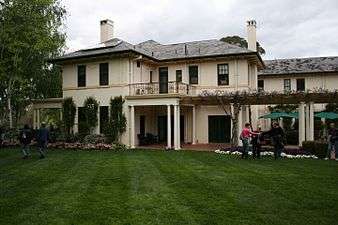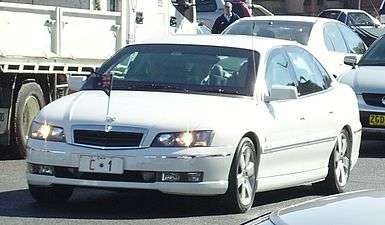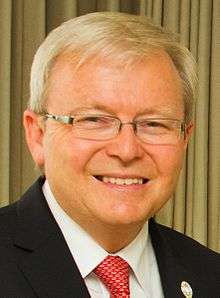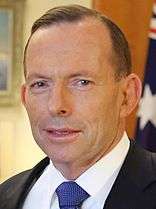Prime Minister of Australia
| Prime Minister of the Commonwealth of Australia | |
|---|---|
|
| |
|
Government of Australia Department of the Prime Minister and Cabinet | |
| Style |
The Honourable (Formal) Prime Minister (Spoken) |
| Member of | |
| Reports to | Parliament |
| Residence |
|
| Seat |
Canberra (primary) Sydney (secondary) |
| Appointer | Governor-General of Australia |
| Term length | At the Governor-General's pleasure |
| Inaugural holder | Edmund Barton |
| Formation | 1 January 1901 |
| Salary | $507,338 (AUD) |
| Website |
pm |
The Prime Minister of the Commonwealth of Australia is the head of government in Australia. The individual who holds the office is the most senior Minister of the Crown, the leader of the Cabinet and the chairperson of the National Security Committee. The office is not mentioned in the Constitution of Australia and exists only through an unwritten political convention and tradition. Despite this, in practice it is the most powerful parliamentary position in Australia. The individual who holds the office is commissioned by the Governor-General of Australia.
Almost always and according to convention, the Prime Minister is the leader of the majority party or largest party in a coalition of parties in the House of Representatives. However, there is no constitutional requirement that the prime minister sit in the House of Representatives, or even be a member of parliament, though by convention this is always the case. The only case where a member of the Senate was appointed prime minister was John Gorton, who subsequently resigned his Senate position and was elected as a member of the House of Representatives (Senator George Pearce was acting prime minister for seven months in 1916 while Billy Hughes was overseas).[1]
Malcolm Turnbull has held the office of Prime Minister since 15 September 2015. He received his commission after replacing Tony Abbott as the leader of the Liberal Party, the dominant party in the Coalition government, following the outcome of the September 2015 Liberal leadership ballot.[2]
Appointment
 |
| This article is part of a series on the politics and government of Australia |
|
|
|
Related topics |
The Prime Minister of Australia is appointed by the Governor-General of Australia under Section 64 of the Australian Constitution, which empowers the Governor-General to appoint Ministers of the Crown and requires such Ministers to be members of the House of Representatives or the Senate, or become members within three months of the appointment. Before being sworn in as a minister, a person must first be sworn in as a member of the Federal Executive Council if they are not already a member. Membership of the Federal Executive Council entitles the member to the style of The Honourable (usually abbreviated to The Hon) for life, barring exceptional circumstances. The senior members of the Executive Council constitute the Cabinet of Australia.
The Prime Minister is, like other ministers, normally sworn in by the Governor-General and then presented with the commission (Letters patent) of office. When defeated in an election, or on resigning, the Prime Minister is said to "hand in the commission" and actually does so by returning it to the Governor-General. In the event of a Prime Minister dying in office, or becoming incapacitated, the Governor-General can terminate the commission. Ministers hold office "during the pleasure of the Governor-General" (s. 64 of the Constitution of Australia), so theoretically, the Governor-General can dismiss a minister at any time, by notifying them in writing of the termination of their commission; however, his or her power to do so except on the advice of the Prime Minister is heavily circumscribed by convention.
Despite the importance of the office of prime minister, the Constitution does not mention the office by name. The conventions of the Westminster system were thought to be sufficiently entrenched in Australia by the authors of the Constitution that it was deemed unnecessary to detail them. The formal title of the portfolio has always been simply "Prime Minister", except for the period of the Fourth Deakin Ministry (June 1909 to April 1910), when it was known as "Prime Minister (without portfolio)".[3]
If a government cannot get its appropriation (budget) legislation passed by the House of Representatives, or the House passes a vote of "no confidence" in the government, the Prime Minister is bound by convention to immediately advise the Governor-General to dissolve the House of Representatives and hold a fresh election.
Following a resignation in other circumstances, or the death of a prime minister, the governor-general will generally appoint as prime minister the person elected as leader by the governing party or, in the case of a coalition, the senior party in the coalition. There have been four notable exceptions to this:
- When Joseph Lyons, prime minister and leader of the United Australia Party (UAP), died suddenly in April 1939, the governor-general, Lord Gowrie, called on Sir Earle Page to become caretaker prime minister. Page was the leader of the smaller party in the governing coalition, the Country Party. He held the office for three weeks until the UAP elected a new leader, Robert Menzies.
- In August 1941 Menzies resigned as prime minister. The UAP was so bereft of leadership at this time that the Country Party leader Arthur Fadden was invited to become prime minister, although the Country Party was the smaller of the two coalition parties. The government depended on support from two independents, who two months later voted against Fadden's budget and brought the government down, paving the way for John Curtin to be appointed as Labor prime minister.
- In July 1945 John Curtin died suddenly. His deputy, Frank Forde, was sworn in the next day as prime minister, although the Labor Party had not had an opportunity to meet and elect a new leader. Forde served for eight days until Ben Chifley was elected leader. Chifley was then sworn in, replacing Forde, who became Australia's shortest-serving prime minister.
- Harold Holt disappeared while swimming on 17 December 1967 and was declared presumed dead on 19 December. The governor-general, Lord Casey, commissioned the Leader of the Country Party, John McEwen, to form a government until the Liberal Party elected a new leader. McEwen was prime minister for 23 days, until the election of (then Senator) John Gorton.
There were only three other cases where someone other than the leader of the majority party in the House of Representatives was prime minister:
- Federation occurred on 1 January 1901, but elections for the first parliament were not scheduled until late March. In the interim, an unelected caretaker government was necessary. In what is now known as the Hopetoun Blunder, the governor-general, Lord Hopetoun, invited Sir William Lyne, the premier of the most populous state, New South Wales, to form a government. Lyne was unable to do so and returned his commission in favour of Edmund Barton, who became the first prime minister and led the inaugural government into and beyond the election.
- During the second parliament, three parties (Free Trade, Protectionist and Labor) had roughly equal representation in the House of Representatives. The leaders of the three parties, Alfred Deakin, George Reid and Chris Watson each served as prime minister before losing a vote of confidence.
- During the 1975 constitutional crisis, on 11 November 1975, the governor-general, Sir John Kerr, dismissed the Labor Party's Gough Whitlam as prime minister. Despite Labor holding a majority in the House of Representatives, Kerr appointed the Leader of the Opposition, Liberal leader Malcolm Fraser as caretaker prime minister, conditional on the passage of the Whitlam government's Supply bills through the Senate and the calling of an election for both houses of parliament. Fraser accepted these terms and immediately advised a double dissolution. An election was called for 13 December, which the Liberal Party won in its own right (although the Liberals governed in a coalition with the Country Party).
Powers

Most of the prime minister's powers derive from being head of Government. In practice, the Federal Executive Council will act to ratify all decisions made by the cabinet and, in practice, decisions of the cabinet will always require the support of the prime minister. The powers of the governor-general to grant Royal Assent to legislation, to dissolve and prorogue parliament, to call elections and to make appointments are exercised on the advice of the prime minister.
The formal power to appoint the Governor-General lies with the Queen of Australia, but this appointment is done on the formal advice of the Prime Minister. By convention, this advice is provided by the Prime Minister alone, and thus the appointment is effectively the Prime Minister's personal choice. The Prime Minister may also advise the monarch to dismiss the Governor-General, though it remains unclear how quickly the monarch would act on such advice in a constitutional crisis. This uncertainty, and the possibility of a "race" between the Governor-General and Prime Minister to sack the other, was a key question in the 1975 constitutional crisis.
The power of the prime minister is subject to a number of limitations. Prime ministers removed as leader of his or her party, or whose government loses a vote of no-confidence in the House of Representatives, must advise an election of the lower house or resign the office or be dismissed by the governor-general.
The prime minister's party will normally have a majority in the House of Representatives and party discipline is exceptionally strong in Australian politics, so passage of the government's legislation through the House of Representatives is mostly a formality. Attaining the support of the Senate can be more difficult as government usually lacks an absolute majority because the Senate's representation is based on overall proportion of votes and often includes minor parties.
Privileges of office
Salary
| Effective date | Salary |
|---|---|
| 2 June 1999 | $289,270 |
| 6 September 2006 | $309,270 |
| 1 July 2007 | $330,356 |
| 1 October 2009 | $340,704[4] |
| 1 August 2010 | $354,671[5] |
| 1 July 2011 | $366,366 |
| 1 December 2011 | $440,000 |
| 15 March 2012 | $481,000[6] |
| 1 July 2012 | $495,430[7] |
| 1 July 2013 | $507,338[8] |
On 1 July 2013, the Australian Government's Remuneration Tribunal adjusted the Prime Ministerial salary, raising it to its current amount of $507,338.
Allowances

Whilst in office, the prime minister has two official residences. The primary official residence is The Lodge in Canberra. Most prime minister’s have chosen The Lodge as their primary residence because of its security facilities and close proximity to Parliament House. There have been some exceptions, however. Jim Scullin preferred to live at the Hotel Canberra (now the Hyatt Hotel) and Ben Chifley lived in the Hotel Kurrajong. More recently, John Howard used the Sydney prime ministerial residence, Kirribilli House, as his primary accommodation. On her appointment on 24 June 2010, Julia Gillard said she would not be living in The Lodge until such time as she was returned to office by popular vote at the next general election. (She became prime minister mid-term after replacing the incumbent, Kevin Rudd, who resigned in the face of an unwinnable party-room ballot.) During his first term, Rudd had a staff at The Lodge consisting of a senior chef and an assistant chef, a child carer, one senior house attendant, and two junior house attendants. At Kirribilli House in Sydney, there is one full-time chef and one full-time house attendant.[9] The official residences are fully staffed and catered for both the prime minister and his or her family. In addition, both have extensive security facilities. These residences are regularly used for official entertaining, such as receptions for Australian of the Year finalists.
The prime minister receives a number of transport amenities for official business. The Royal Australian Air Force's No. 34 Squadron transports the prime minister within Australia and overseas by specially converted Boeing Business Jets and smaller Challenger aircraft. The aircraft contain secure communications equipment as well as an office, conference room and sleeping compartments. The call-sign for the aircraft is "Envoy". For ground travel, the prime minister is transported in an armoured BMW 7 Series model. It is referred to as "C-1", or Commonwealth One, because of its licence plate. It is escorted by police vehicles from state and federal authorities.[10]
After office
Prime ministers are usually granted certain privileges after leaving office, such as office accommodation, staff assistance, and a Life Gold Pass, which entitles the holder to travel within Australia for "non-commercial" purposes at government expense.
Only one prime minister who had left the Federal Parliament ever returned. Stanley Bruce was defeated in his own seat in 1929 while prime minister, but was re-elected to parliament in 1931. Other prime ministers were elected to parliaments other than the Australian federal parliament: Sir George Reid was elected to the UK House of Commons (after his term as High Commissioner to the UK); and Frank Forde was re-elected to the Queensland Parliament (after his term as High Commissioner to Canada, and a failed attempt to re-enter the Federal Parliament).
- Privileges of Office
Acting and interim prime ministers
From time to time prime ministers are required to leave the country on government business and a deputy acts in their place during that time. In the days before jet aircraft, such absences could be for extended periods. For example, William Watt was acting prime minister for 16 months, from April 1918 until August 1919, when Prime Minister Billy Hughes was away at the Paris Peace Conference,[11] and Senator George Pearce was acting Prime Minister for more than seven months in 1916.[12] An acting Prime Minister is also appointed when the prime minister takes leave. The Deputy Prime Minister most commonly becomes acting Prime Minister in those circumstances.
Three prime ministers have died in office – Joseph Lyons (1939), John Curtin (1945) and Harold Holt (1967) – and Robert Menzies resigned as Prime Minister in 1941. In each of these cases the Deputy Prime Minister (an unofficial office at the time) became an interim Prime Minister, pending an election of a new leader of the government party. In none of these cases was the interim Prime Minister successful at the subsequent election.
The powers and duties of an acting or interim Prime Minister is analogous to that of a caretaker Prime Minister.
Timeline

Living former prime ministers
As of December 2016, there are six living former Australian Prime Ministers.
The greatest number of living former prime ministers at any one time was eight. This has occurred twice:
- Between 7 October 1941 (when John Curtin succeeded Arthur Fadden) and 18 November 1941 (when Chris Watson died), the eight living former prime ministers were Bruce, Cook, Fadden, Hughes, Menzies, Page, Scullin and Watson.
- Between 13 July 1945 (when Ben Chifley succeeded Frank Forde) and 30 July 1947 (when Sir Joseph Cook died), the eight living former prime ministers were Bruce, Cook, Fadden, Forde, Hughes, Menzies, Page and Scullin.
Convictions
John Curtin is the only prime minister to serve time in prison (three days for failing to comply with an order for a compulsory medical examination for conscription, during World War I).[13]
Ages
The three youngest people when they first became prime minister were:
- Chris Watson – 37
- Stanley Bruce – 39
- Robert Menzies – 44
The three oldest people when they first became prime minister were:
- John McEwen – 67
- William McMahon – 63
- Malcolm Turnbull – 60
The three youngest people to last leave the office of prime minister were:
- Chris Watson – 37
- Arthur Fadden – 46 years 5 months 22 days
- Stanley Bruce – 46 years 6 months 7 days
The three oldest people to last leave the office of prime minister were:
- Robert Menzies – 71
- John Howard – 68
- John McEwen – 67
Time in office
The longest serving prime minister was Sir Robert Menzies, who served in office twice: from 26 April 1939 to 28 August 1941, and again from 19 December 1949 to 26 January 1966. In total Robert Menzies spent 18 years, 5 months and 12 days in office. He served under the United Australia Party and the Liberal Party respectively.
The shortest-serving prime minister was Frank Forde, who was appointed to the position on 6 July 1945 after the death of John Curtin, and served until 13 July 1945 when Ben Chifley was elected leader of the Australian Labor Party.
Post-office longevity
Six former prime ministers are living: Hawke, Keating, Howard, Rudd, Gillard and Abbott.[14]
Ben Chifley died only one year and six months after leaving the prime ministership. Alfred Deakin lived another nine years and five months.[15]
All the others who have left office at least 10 years ago have lived at least another 10 years. Nine of them (Bruce, Cook, Fadden, Forde, Fraser, Gorton, Hughes, Watson, and Whitlam) lived more than 25 years after leaving the office, and all but one of them have survived longer than 30 years (Hughes lived for 29 years and 8 months following service).
The longest-surviving was Gough Whitlam, who lived 38 years and 11 months after office, surpassing Stanley Bruce's previous record of 37 years and 10 months after leaving the office.[16]
See also
- List of Prime Ministers of Australia
- Deputy Prime Minister of Australia
- List of Prime Ministers of Australia by time in office
- Prime Ministers Avenue in Horse Chestnut Avenue in the Ballarat Botanical Gardens contains a collection of bronze busts of former Australian prime ministers.
- List of Australian Leaders of the Opposition
- Historical rankings of Prime Ministers of Australia
- List of Prime Ministers of Australia with facial hair
- Spouse of the Prime Minister of Australia
- Transportation of the Prime Minister of Australia
- Prime Ministers of Queen Elizabeth II
- List of Commonwealth Heads of Government
- List of Privy Counsellors (1952–present)
References
- ↑ "Pearce, Sir George Foster (1870–1952)". Australian Dictionary of Biography. Australian National University. 2006. Retrieved 24 June 2010.
- ↑ "Malcolm Turnbull sworn in as Australia's 29th Prime Minister". ABC News. 15 September 2015. Retrieved 15 September 2015.
- ↑ "ParlInfo – Part 6 – Historical information on the Australian Parliament : Ministries and Cabinets". aph.gov.au.
- ↑ "Prime Minister Kevin Rudd and MPs in line to get a 3% pay rise".
- ↑ Hudson, Phillip (25 August 2010). "Politicians awarded secret pay rise". Herald Sun. Australia.
- ↑ Archived 13 April 2013 at the Wayback Machine.
- ↑ "Tony Abbott defends increase in MP salary, saying he's working hard for every Australian". Herald Sun. 5 July 2012.
- ↑ Peatling, Stephanie (14 June 2013). "PM's salary tops $500,000". Sydney Morning Herald.
- ↑ Metherell, Mark (19 February 2008). "Rudds' staff extends to a child carer at the Lodge". The Sydney Morning Herald. Retrieved 24 June 2010.
- ↑ CarAdvice.com.au (6 April 2009). "25% of government car fleet foreign made". Car Advice. Retrieved 12 December 2011.
- ↑ "Australian Dictionary of Biography – William Alexander Watt". ADB ANU. Retrieved 21 October 2014.
- ↑ "Australian Dictionary of Biography – Sir George Foster Pearce". ADB ANU. Retrieved 21 October 2014.
- ↑ "Curtin, John (1885–1945)". Australian Dictionary of Biography. Australian National University. 2006. Retrieved 24 June 2010.
- ↑ Cox, Lisa. "The 'special moment' seven surviving prime ministers were photographed together".
- ↑ "After office". naa.gov.au.
- ↑ "Prime Minister of Australia". Australian Policy Online.
External links
| Library resources about Prime Minister of Australia |
| Wikimedia Commons has media related to Prime Minister of Australia. |
- Official website of the Prime Minister of Australia
- Department of Prime Minister and Cabinet
- Australia's Prime Ministers – National Archives of Australia reference site and research portal
- Biographies of Australia's Prime Ministers / National Museum of Australia
- Classroom resources on Australian Prime Ministers


Kirribilli_House_Kirribilli.jpg)

_CBR_Gilbert-1.jpg)



.jpg)
